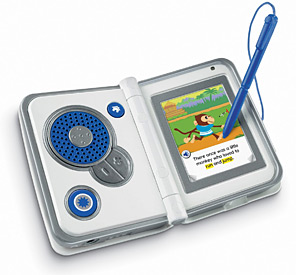iXL electronic learning tool
Six-in-one learning system from Fisher-Price
 Handheld learning systems have gone through many iterations over the years. The question always: is this a replacement for classroom or tutor-based learning? The answer is always no: not a replacement, not a substitute, but rather a supplement. What an educational toy like this does is make learning mobile and enjoyable. Thus on a long car ride, a child can learn, rather than simply play a handheld video game system. A learning system is designed with the consultation of experts in the field of effective learning. That is how iXL is built: to create the right connections between patterns and things, whether mathmatical representations or verbal constructs.
Handheld learning systems have gone through many iterations over the years. The question always: is this a replacement for classroom or tutor-based learning? The answer is always no: not a replacement, not a substitute, but rather a supplement. What an educational toy like this does is make learning mobile and enjoyable. Thus on a long car ride, a child can learn, rather than simply play a handheld video game system. A learning system is designed with the consultation of experts in the field of effective learning. That is how iXL is built: to create the right connections between patterns and things, whether mathmatical representations or verbal constructs.
Electronic learning systems play a valuable role in enhancing education, but they should be viewed as a supplement rather than a replacement for traditional classroom or tutor-based learning. Here's how electronic learning systems complement and support these traditional methods:
Personalized Learning: Electronic learning systems can adapt to individual learning styles and paces, providing personalized instruction. However, they lack the nuanced understanding and real-time feedback that a teacher or tutor can provide in response to a student's unique needs.
Engagement and Practice: Interactive activities and games in electronic learning systems engage students and encourage practice. While they reinforce concepts, they may lack the depth of explanation and context that a teacher can provide in a classroom setting.
Accessible Resources: Electronic learning systems offer a vast array of resources, allowing students to explore various subjects at their own convenience. These resources can complement classroom lessons by providing additional practice and exploration opportunities.
Supplementary Reinforcement: Electronic learning systems can reinforce classroom or tutor-based learning by providing extra practice and repetition. They can help students solidify concepts learned in a traditional setting.
Visual and Interactive Learning: Many electronic learning systems use visual and interactive elements that resonate well with modern learners. These elements can make learning engaging and enjoyable, but they may lack the interpersonal and social dynamics of a classroom.
Flexibility: Electronic learning systems offer flexibility in terms of when and where students can learn. This flexibility is beneficial, but it doesn't replace the benefits of direct interaction with a teacher or peers in a classroom environment.
Structured Curriculum: Classroom and tutor-based learning provide a structured curriculum and a guided learning path. While electronic systems can offer structured modules, they may not provide the same level of guidance and mentorship as a teacher or tutor.
Real-Time Interaction: In a classroom or tutor-based setting, students can ask questions and receive immediate answers, promoting a deeper understanding of the material. Electronic learning systems may offer FAQs or automated responses, but they can't replicate the personalized guidance of an instructor.
Soft Skills and Social Interaction: Classroom learning fosters the development of soft skills like communication, teamwork, and collaboration. These skills are difficult to acquire solely through electronic systems, as they require face-to-face interactions and real-world experiences.
Critical Thinking and Discussion: Classroom learning encourages critical thinking, analysis, and class discussions. Electronic systems may provide information but lack the depth of discussion and debate that occurs in a classroom setting.
Ultimately, electronic learning systems serve as a valuable tool to supplement classroom and tutor-based learning. They offer flexibility, practice, and engagement, but they can't replace the essential role of teachers, mentors, and peer interactions in creating a holistic and well-rounded educational experience.
